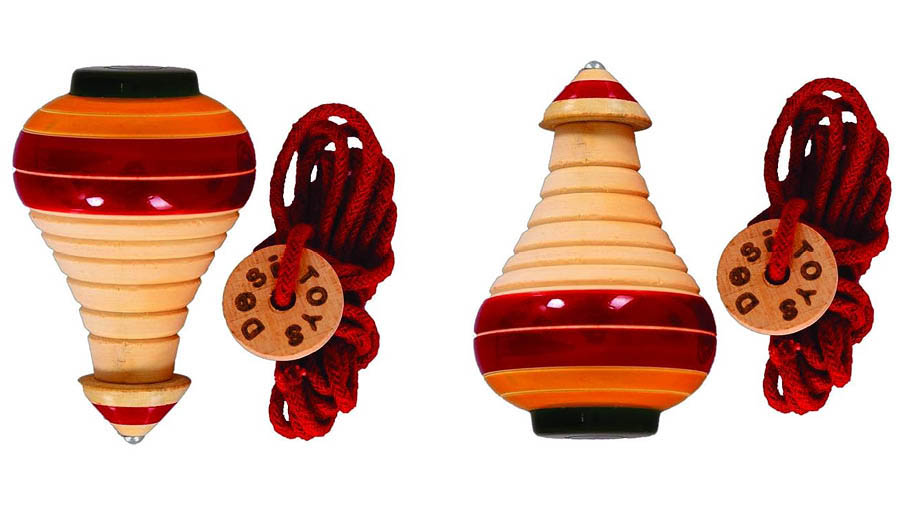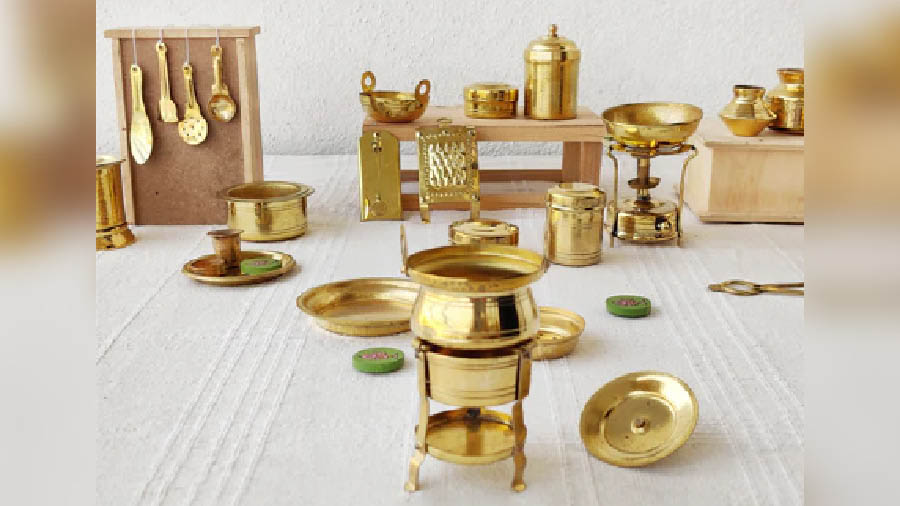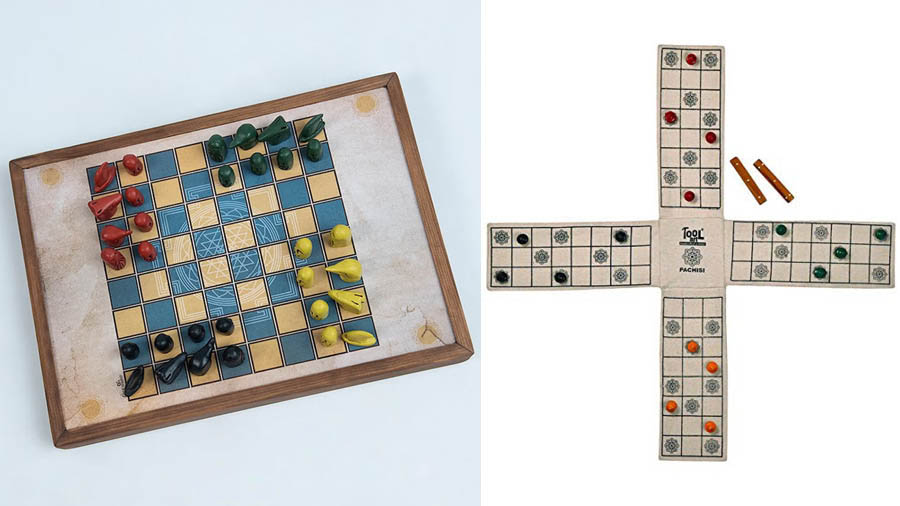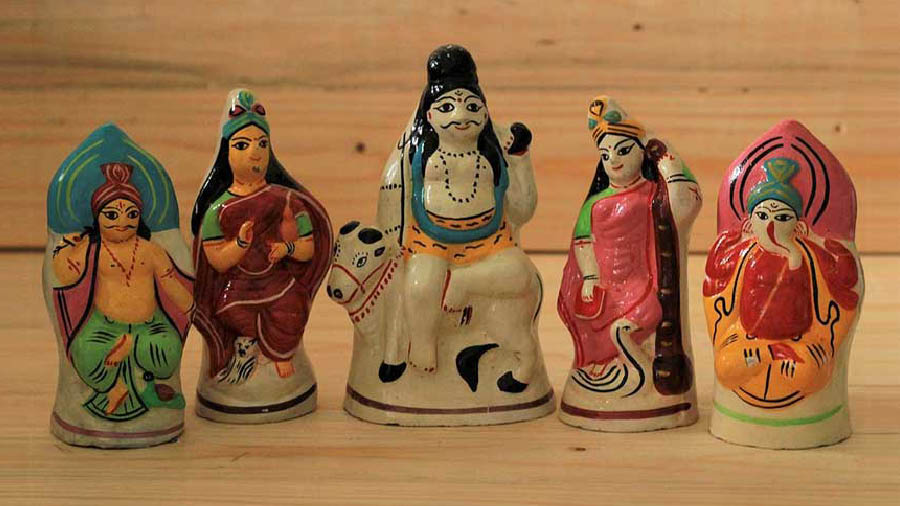Toys have been a part of everyone’s childhood since time immemorial. The history of Indian toys dates back to almost 5,000 years. Toys like small carts, dancing women have even been found in Mohenjodaro and Harappa. Toys also carry forward the heritage and culture of a place.
Advent of modern-day toys might have relegated traditional Indian toys to the background but online ecommerce has infused fresh life into such gems by drumming up their popularity and making them easily available for millennials.
My Kolkata takes a look at some of the traditional toys of India.

Desi Toys Spinning Tops
Lattu
The first on the list is lattu or spinning top. Lattu is one of the oldest known toys. The wooden lattu emerged around 2000 BC This simple toy has been one of the eternal favourites of children since thousands of years and are still easily available in the market. The conical-shaped wooden lattu starts spinning when a coil attached to its axis is pulled fast. Lattu is mostly available at all toy stores. Not only wooden ones, the modern spinning tops are also available in plastic and with LED lights too.
Age group: 6 years and above
Price range: Rs 50 and above
Pachisi
Pachisi is the traditional form of the modern-day ludo. It is an ancient board game and its name means 25 in Hindi The game has its origin in India. It is played on a board with a symmetrical cross. Two or four players test their skill as well as their luck. A player’s pieces move round the board based on the players. Six or seven cowrie shells are thrown and the number of shells resting with the aperture upward indicate the number of spaces to move. There are different versions of the game named differently like Chaupar in Pakistan and India, Parques is the Columbian variant, Parchis in Spain and northern Morocco. References to this game under the name of pasha are found in Mahabharata.
Age group: Ludo and pachisi can be played from age 4 and above but Pachisi usually as seen was played by adults
Price range: Pachisi costs Rs 500 and above

Bhatukli Full Set of Brass Toys
Bhatukali
Remember those long hours spent cooking up a feast days with tiny utensil sets? Known as rannabaati in Bengal, Bhatukali or Bhatukli is the miniature cooking set for children originating in Maharashtra. They can be made from different materials like copper, bchildren that originated in Maharashtra. They can be made of different materials like copper, bronze, clay, silver and wood. Though the manufacturers believe that the toy is losing popularity with plastic sets replacing them, there are some shops where you still get the traditional version.
Age group: This miniature kitchen set can be played from ages 5 and above. The modern kitchen sets that are usually plastic made can be considered as a form of this toy
Price range: Starts from Rs 500

Indian Chess Chaturanga and (right) Toolart Pachisi
Chaturanga
Chaturanga is an ancient Indian board game. It is considered by some to be the origin of chess. The Sanskrit word ‘chaturanga’ means four-limbed referring to ancient army divisions of infantry, cavalry, elephantry and chariotry. An ancient battle formation, akshauhini is like the set up of Chaturanga. Similar board games are found in China named as Xiangqi, Shogi in Japan. Chaturang is also called shatranj.
Channapatna toys
These colourful wooden toys are made in the Channapatna and Ramanagara districts of Karnataka. These toys have also earned a GI tag. For its popularity, Channapatna is referred as the toy town of Karnataka. Tipu Sultan was a big patron of these toys though its origin can be traced before this period too. With time, the toys underwent changes. Japanese toy-making techniques were introduced by a person named Bavas Miyan. Ivory wood is the main wood that was used to make the toys. Sometimes sandalwood and rosewood were also used. Now, pine, teak, rubber, and sycamore are also used. The modern- day rattles may have taken birth from Channapatna toys though Channapatna toys are made completely with wood and plastic is not used.
Age group: Though they can be given to small kids but since wood is used has to be given under adult supervision
Price range: Rs 500 and above
Kondapalli toys
In a small place of Vijayawada in Andhra Pradesh named Kondapalli, wooden toys have been crafted for 400 years. Made of soft wood called tell poniki (available locally), these toys are a mark of the cultural heritage of the region. Mythological figures, animals and birds figures are mainly carved out. The most famous is the Dasavatharam of dancing dolls. The artisans who are called Nakarshalu are said to have originated from Rajasthan. All the parts of the toys are made separately. The parts are joined with glue made from tamarind seeds and sawdust. These toys are one the varieties of toys that are assembled in houses in festivals like navratri and Sankranti and are called Bommala Kolavu.
Age group: 3 and above
Price range: Rs 400 and above
Natungram dolls
If you happen to go to any handicrafts fair of West Bengal, you will come across brightly coloured wooden owls, Radha Krishna, Gour- Nitai, raja-rani figurines. All these wooden toys are made mainly in a place named Notungram in Bardhaman district of West Bengal. Though the dolls were originally carved out of stone, later they came to be carved out of wood.
Usually the dolls are made from mango and jackfruit wood.
Age group: 3 and above
Price range: Rs 30 and above

Dolls of Bengal
Dolls of Bengal
In Joynagar’s Mojilpur (South 24-Parganas) unique clay dolls are made by hand. This beautiful tradition is vanishing as only one person in the entire area knows the art now.
The Heem Putul of Bishnupur or Kanthalia dolls of Murshidabad or miniature shellac dolls (galar putul) of Purba Medinipur are also almost extinct now. Heem Putul gets its name from ‘hingul’, a red mineral consisting of mercury sulphide that is used to paint them. The soft clay dolls are sun-dried and then dyed with herbal, nature-friendly colours. Galar Putul from Medinipur are made from hand-pressed soil gathered from white ant hills. The Kanthalia dolls of Murshidabad, crafted by the potter community, usually depict household characters. The clay dolls are available during rather mela in West Bengal. Some clay toys are also available during Jhulan Utsab.
Age group: 3 and above
Price range: Rs 50 and above
Thanjavur dolls
These dolls originate from Tanjore, Tamil Nadu. The most interesting feature is their slow dance-like continuous movement at a slight oscillation. It’s kind of a roly-poly toy that is made of terracotta. The centre of gravity and the weight concentrates at the bottom of the dolls and hence the movement. They are hand-made and usually painted. They are traditionally called Thanjavur Thalaiyatti Bommai.
Age group: 3 and above
Price range: Rs 500 and above
Pallanguzhi
This is a board game popular in southern parts of India specially Tamil Nadu. and Kerala. The game is played between 2 players who play on a board that has 14 pits. The pits contain cowrie shells, tamarind seeds or shells. This game is also popular in Sri Lanka and Malaysia. It is also called Pallankuli.
Age group: 5 and above
Price range: Rs 600 and above
